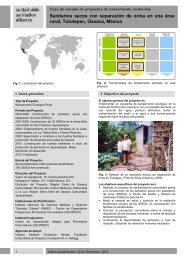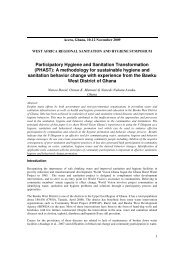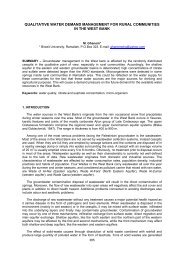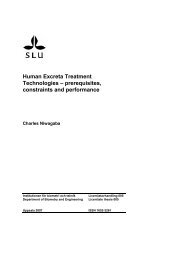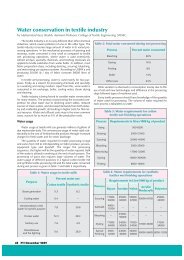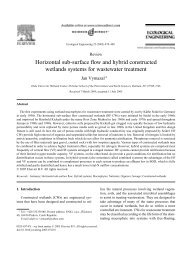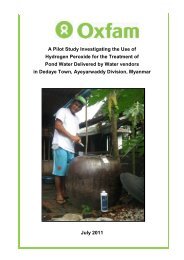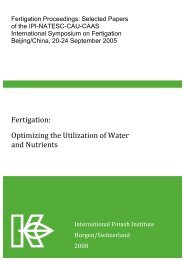Compilation of 13 factsheets on key sustainable sanitation ... - SSWM
Compilation of 13 factsheets on key sustainable sanitation ... - SSWM
Compilation of 13 factsheets on key sustainable sanitation ... - SSWM
Create successful ePaper yourself
Turn your PDF publications into a flip-book with our unique Google optimized e-Paper software.
Key messages <str<strong>on</strong>g>of</str<strong>on</strong>g> each factsheet are provided below:<br />
Factsheet <str<strong>on</strong>g>of</str<strong>on</strong>g> WG 1 <strong>on</strong> "Capacity development for <strong>sustainable</strong><br />
sanitati<strong>on</strong>" provides an overview <strong>on</strong> basic principles<br />
<str<strong>on</strong>g>of</str<strong>on</strong>g> capacity development and addresses current challenges<br />
and gaps in capacity development for <strong>sustainable</strong><br />
sanitati<strong>on</strong>, as well as possible strategies and instruments to<br />
address those. Furthermore it c<strong>on</strong>tains a list <str<strong>on</strong>g>of</str<strong>on</strong>g> examples and<br />
c<strong>on</strong>tact details <str<strong>on</strong>g>of</str<strong>on</strong>g> capacity development initiatives from the<br />
sector. The <strong>key</strong> messages are:<br />
✬ Capacity development for <strong>sustainable</strong> sanitati<strong>on</strong> requires<br />
cross-sectoral cooperati<strong>on</strong> with individuals and within<br />
organisati<strong>on</strong>s from health, infrastructure, water, envir<strong>on</strong>ment,<br />
agriculture, educati<strong>on</strong>, ec<strong>on</strong>omic development etc.<br />
✬ It c<strong>on</strong>siders the complexity <str<strong>on</strong>g>of</str<strong>on</strong>g> sanitati<strong>on</strong> systems and<br />
takes place al<strong>on</strong>g the sanitati<strong>on</strong> chain, c<strong>on</strong>sidering all<br />
technical, fi nancial, social and instituti<strong>on</strong>al aspects.<br />
✬ It includes a variety <str<strong>on</strong>g>of</str<strong>on</strong>g> methods: educati<strong>on</strong>, pr<str<strong>on</strong>g>of</str<strong>on</strong>g>essi<strong>on</strong>al<br />
training, support for documentati<strong>on</strong> <str<strong>on</strong>g>of</str<strong>on</strong>g> appropriate local<br />
infrastructure and sharing knowledge in print, <strong>on</strong>line and<br />
multi-media.<br />
Factsheet <str<strong>on</strong>g>of</str<strong>on</strong>g> WG 2 <strong>on</strong> "Financial and ec<strong>on</strong>omic analysis"<br />
introduces c<strong>on</strong>cepts <str<strong>on</strong>g>of</str<strong>on</strong>g> costs and ec<strong>on</strong>omics in c<strong>on</strong>necti<strong>on</strong><br />
with <strong>sustainable</strong> sanitati<strong>on</strong>, and describes the applicati<strong>on</strong> <str<strong>on</strong>g>of</str<strong>on</strong>g><br />
and differences between fi nancial and ec<strong>on</strong>omic analyses. It<br />
provides an overview <str<strong>on</strong>g>of</str<strong>on</strong>g> analytical approaches for comparing<br />
sanitati<strong>on</strong> interventi<strong>on</strong>s, and illustrates these approaches<br />
using evidence from existing studies. The main focus is to<br />
provide a basis for fi nancial decisi<strong>on</strong>s c<strong>on</strong>cerning the scaling<br />
up <str<strong>on</strong>g>of</str<strong>on</strong>g> sanitati<strong>on</strong> services. The data generated by fi nancial and<br />
ec<strong>on</strong>omic analyses have major implicati<strong>on</strong>s for the programming<br />
and design <str<strong>on</strong>g>of</str<strong>on</strong>g> sanitati<strong>on</strong> projects.<br />
Factsheet <str<strong>on</strong>g>of</str<strong>on</strong>g> WG 3 <strong>on</strong> "Links between sanitati<strong>on</strong>, climate<br />
change and renewable energies" argues that <strong>sustainable</strong><br />
sanitati<strong>on</strong> projects can c<strong>on</strong>tribute to both climate change mitigati<strong>on</strong><br />
(through energy or nutrient recovery) and to climate<br />
change adaptati<strong>on</strong> (through innovative sanitati<strong>on</strong> systems<br />
and wastewater management). Measures for renewable<br />
energy producti<strong>on</strong> c<strong>on</strong>sist <str<strong>on</strong>g>of</str<strong>on</strong>g> either biogas producti<strong>on</strong> from<br />
wastewater or biomass producti<strong>on</strong> through the use <str<strong>on</strong>g>of</str<strong>on</strong>g> wastewater<br />
to grow short rotati<strong>on</strong> plantati<strong>on</strong>s for fi rewood. Measures<br />
<str<strong>on</strong>g>of</str<strong>on</strong>g> nutrient recovery are primarily based <strong>on</strong> nitrogen<br />
reuse. Adaptati<strong>on</strong> measures in the area <str<strong>on</strong>g>of</str<strong>on</strong>g> sanitati<strong>on</strong> aim at<br />
coping with increasing water scarcity or fl ooding.<br />
10 – Executive summary<br />
Factsheet <str<strong>on</strong>g>of</str<strong>on</strong>g> WG 4 <strong>on</strong> "Sanitati<strong>on</strong> systems and technology<br />
opti<strong>on</strong>s" highlights the fact that with so many innovati<strong>on</strong>s<br />
and existing technologies for different settings, diffi culties<br />
with knowledge disseminati<strong>on</strong> hinder informed decisi<strong>on</strong><br />
making and the integrati<strong>on</strong> <str<strong>on</strong>g>of</str<strong>on</strong>g> all sanitati<strong>on</strong> elements with<br />
each other and the water and nutrient cycle. This factsheet<br />
makes a plea for a sanitati<strong>on</strong> system approach where technologies<br />
are categorised based <strong>on</strong> their "product-process"<br />
characteristics and then linked into logical systems using a<br />
"fl owstream" c<strong>on</strong>cept. This method for organising and defi ning<br />
sanitati<strong>on</strong> systems helps facilitate informed decisi<strong>on</strong><br />
making and c<strong>on</strong>siderati<strong>on</strong> <str<strong>on</strong>g>of</str<strong>on</strong>g> an integrated approach. By<br />
using the sanitati<strong>on</strong> system and its technology c<strong>on</strong>fi gurati<strong>on</strong>s<br />
other aspects can be further highlighted such as the inherent<br />
implicati<strong>on</strong>s for operati<strong>on</strong> and management, business and<br />
management models, service and supply chains, possible<br />
involved stakeholders, and fi nally the associated health risks<br />
by exposure <str<strong>on</strong>g>of</str<strong>on</strong>g> different groups <str<strong>on</strong>g>of</str<strong>on</strong>g> people to waste products.<br />
Factsheet <str<strong>on</strong>g>of</str<strong>on</strong>g> WG 5 <strong>on</strong> "Productive sanitati<strong>on</strong> and the link<br />
to food security" provides informati<strong>on</strong> <strong>on</strong> the link between<br />
sanitati<strong>on</strong> and agriculture as well as related implicati<strong>on</strong>s <strong>on</strong><br />
health, ec<strong>on</strong>omy and the envir<strong>on</strong>ment. It shows examples <str<strong>on</strong>g>of</str<strong>on</strong>g><br />
treating and using treated excreta and wastewater in food producti<strong>on</strong><br />
and describes the potential for urban agriculture and<br />
resource recovery in rural areas thereby c<strong>on</strong>tributing to food<br />
security and helping to reduce malnutriti<strong>on</strong>. Instituti<strong>on</strong>al and<br />
legal aspects, business opportunities and how to manage<br />
associated health risks are also discussed. Productive sanitati<strong>on</strong><br />
is the term used for the variety <str<strong>on</strong>g>of</str<strong>on</strong>g> sanitati<strong>on</strong> systems that<br />
make productive use <str<strong>on</strong>g>of</str<strong>on</strong>g> the nutrient, organic matter, water<br />
ansedd energy c<strong>on</strong>tent <str<strong>on</strong>g>of</str<strong>on</strong>g> human excreta and wastewater in<br />
agricultural producti<strong>on</strong> and aquaculture. The implementati<strong>on</strong><br />
and scaling-up <str<strong>on</strong>g>of</str<strong>on</strong>g> productive sanitati<strong>on</strong> systems is inhibited by<br />
weak, n<strong>on</strong>-existing and sometimes prohibiting legislati<strong>on</strong>. It is<br />
therefore necessary to develop relevant legislati<strong>on</strong> al<strong>on</strong>g the<br />
sanitati<strong>on</strong> chain taking into c<strong>on</strong>siderati<strong>on</strong> the type <str<strong>on</strong>g>of</str<strong>on</strong>g> crops,<br />
occupati<strong>on</strong>al health, food hygiene and other preventive and<br />
risk management measures.<br />
Factsheet <str<strong>on</strong>g>of</str<strong>on</strong>g> WG 6 <strong>on</strong> "Planning <str<strong>on</strong>g>of</str<strong>on</strong>g> <strong>sustainable</strong> sanitati<strong>on</strong><br />
for cities" deals with the planning <str<strong>on</strong>g>of</str<strong>on</strong>g> <strong>sustainable</strong> sanitati<strong>on</strong><br />
for urban and peri-urban areas to achieve comprehensive<br />
and inclusive sanitati<strong>on</strong> coverage in cities. It<br />
elaborates <strong>on</strong> the shortcomings <str<strong>on</strong>g>of</str<strong>on</strong>g> supply-driven planning<br />
and presents three demand-led approaches which recog-



